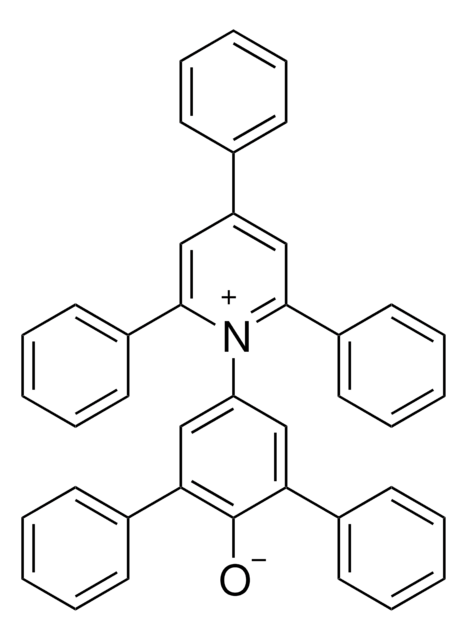Dye solar cells degrade from ultraviolet radiation. For this reason, the barrier may include UV stabilizers and/or UV absorbing luminescent chromophores (which emit at longer wavelengths) and antioxidants to protect and improve the effieciency of the cell.
703168
cis-Bis(isothiocyanato)(2,2′-bipyridyl-4,4′-dicarboxylato)(4,4′-di-nonyl-2′-bipyridyl)ruthenium(II)
95% (NMR)
Sinónimos:
Greatcell Solar®, Z-907 dye
Seleccione un Tamaño
290,00 €
Seleccione un Tamaño
About This Item
290,00 €
Productos recomendados
Nivel de calidad
Ensayo
95% (NMR)
Formulario
powder
composición
Dye content, ≥90%
mp
196 °C
λmáx.
531, 314, 295 nm (lit.)
cadena SMILES
S=C=N[Ru]N=C=S.OC(=O)c1ccnc(c1)-c2cc(ccn2)C(O)=O.CCCCCCCCCc3ccnc(c3)-c4cc(CCCCCCCCC)ccn4
InChI
1S/C28H44N2.C12H8N2O4.2CNS.Ru/c1-3-5-7-9-11-13-15-17-25-19-21-29-27(23-25)28-24-26(20-22-30-28)18-16-14-12-10-8-6-4-2;15-11(16)7-1-3-13-9(5-7)10-6-8(12(17)18)2-4-14-10;2*2-1-3;/h19-24H,3-18H2,1-2H3;1-6H,(H,15,16)(H,17,18);;;/q;;2*-1;+2
Clave InChI
LALSZYPVVQFXIC-UHFFFAOYSA-N
Categorías relacionadas
Aplicación
Información legal
Greatcell Solar is a registered trademark of Greatcell Solar Materials Pty Ltd.
Palabra de señalización
Warning
Frases de peligro
Consejos de prudencia
Clasificaciones de peligro
Eye Irrit. 2 - Skin Irrit. 2 - Skin Sens. 1 - STOT SE 3
Órganos de actuación
Respiratory system
Código de clase de almacenamiento
11 - Combustible Solids
Clase de riesgo para el agua (WGK)
WGK 3
Punto de inflamabilidad (°F)
Not applicable
Punto de inflamabilidad (°C)
Not applicable
Equipo de protección personal
dust mask type N95 (US), Eyeshields, Faceshields, Gloves
Elija entre una de las versiones más recientes:
¿Ya tiene este producto?
Encuentre la documentación para los productos que ha comprado recientemente en la Biblioteca de documentos.
Los clientes también vieron
Artículos
Dye-sensitized solar cells directly convert sunlight to electricity
Operation principle and market dominance of single crystalline silicon solar cells.
Organic materials in optoelectronic devices like LEDs and solar cells are of significant academic and commercial interest.
Dye-sensitized solar cells (DSCs) are 3rd generation solar cells combining the promise of high efficiency with low production costs.
-
What can cause degradation of the dye solar cell?
1 respuesta-
¿Le ha resultado útil?
-
-
What is the Department of Transportation shipping information for this product?
1 respuesta-
Transportation information can be found in Section 14 of the product's (M)SDS.To access the shipping information for this material, use the link on the product detail page for the product.
¿Le ha resultado útil?
-
-
What are the advantages of dye solar cells?
1 respuesta-
Dye solar cells (DSCs) are 3rd generation solar cells with the promise of high efficiency combined with low production costs.
¿Le ha resultado útil?
-
-
What are the disadvantages of dye solar cells?
1 respuesta-
The major disadvantage to the dye solar cell design is the use of a liquid electrolyte, which has temperature stability issues. The electrolyte can freeze at low temperatures and expand at higher temperatures. It the electrolytes freezes, power production would cease, and it could potentially lead to physical damage. If the liquid expands at higher temperatures, sealing the panels would be difficult.
¿Le ha resultado útil?
-
Filtros activos
Nuestro equipo de científicos tiene experiencia en todas las áreas de investigación: Ciencias de la vida, Ciencia de los materiales, Síntesis química, Cromatografía, Analítica y muchas otras.
Póngase en contacto con el Servicio técnico





2 ≥95%](/deepweb/assets/sigmaaldrich/product/structures/190/371/c5efe61d-383f-4364-90c6-1912d88674f3/640/c5efe61d-383f-4364-90c6-1912d88674f3.png)









